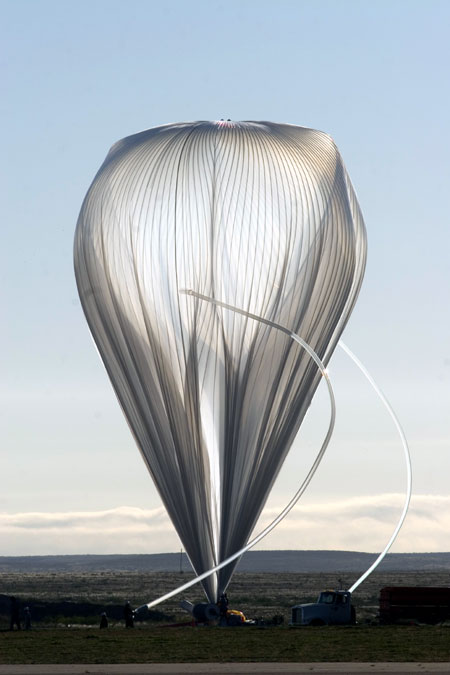
Scientists have successfully tested a floating solar telescope that hovered high in the Earth's atmosphere while tethered to an air balloon the size of a jumbo jet.
The helium balloon and its attached gondola of scientific instruments were launched on Oct. 3 from the Columbia Scientific Balloon Facility in Fort Sumner, New Mexico. The balloon-observatory reached an altitude of nearly 23 miles (37 kilometers) and remained aloft for about 10 hours, capturing stable images and collecting other data of the sun's surface. The gondola separated from the balloon and descended to Earth on a parachute, landing safely in a farm field in Texas.
The test clears the way for "Sunrise," a long-duration polar balloon flight planned for mid-2009 that will study the structure and dynamics of magnetic fields on the sun's surface with a 1-meter (39-inch) lens--the largest solar telescope ever deployed into the atmosphere or space.
"This unique project will enable us to view features of the sun that we've never seen before," said project team member Michael Knolker, director of National Center for Atmospheric Research's High Altitude Observatory in Boulder, Colo. "We hope to unlock important mysteries about the sun's magnetic field structure, which at times can cause electromagnetic storms in our upper atmosphere and may have an impact on Earth's climate."
Floating laboratories
Sunrise could pave the way for a new generation of balloon-borne telescope missions that cost less than sending instruments into space, the scientists say.
"Nowadays, if you were to convince NASA to build a solar telescope with a 1-meter [lens], you would not be able to do that for less than $500 million," Knolker told SPACE.com. "Most likely, it will be a billion-dollar-class enterprise."
Get the Space.com Newsletter
Breaking space news, the latest updates on rocket launches, skywatching events and more!
Scientists associated with the Sunrise project estimate it will cost between $60 million to $80 million.
Another advantage of balloon-based observation platforms is that instruments can be recycled and updated for future missions with the latest technologies. "That is a tremendous advantage as compared to a satellite that is deployed once and for all," Knolker said.
Alex Pevtsov, a NASA program scientist for solar physics in Washington, D.C., involved in determining Sunrise's funding, called the test flight a "great success." Pevtsov also sees balloon missions as a test bed for technologies to be flown in space.
"If you want to develop something new, that would be a way to test how things work," Pevtsov said in a telephone interview.
Nonstop observing
Sunrise is slated for a multi-day flight over the Arctic in summer 2009, where it will take advantage of the midnight sun in the high latitudes to snap images continuously for up to two weeks at a time. The continuous telescope observations will enable scientists to witness in real-time changes in the sun's magnetic field without the interruption of night.
The balloon's high altitude will also mean the telescope won't have to contend with image-blurring turbulence or ultraviolet-absorbing water vapor and ozone.
The telescope's large lens will give it a resolution more than double that of current space-based instruments and will be capable of imaging features on the sun's surface as small as 19 miles (30 kilometers) across.
That sharp resolution will be necessary to resolve the smallest scale structures predicted by theory to drive what Knolker dubs the "solar magnetic machine."
"The problem of solar magnetism is hard to tackle because all scales—from the largest to the smallest—matter," Knolker said. "The scale of the whole sun is a relevant scale, and then all the smaller scales up to it are also relevant for a complete description of the physical processes that give rise to activity."
- Video: Sunrise Test Launch
- Video: Lighter-than-Air Telescope
- The Enduring Mysteries of the Sun
Join our Space Forums to keep talking space on the latest missions, night sky and more! And if you have a news tip, correction or comment, let us know at: community@space.com.
Ker Than is a science writer and children's book author who joined Space.com as a Staff Writer from 2005 to 2007. Ker covered astronomy and human spaceflight while at Space.com, including space shuttle launches, and has authored three science books for kids about earthquakes, stars and black holes. Ker's work has also appeared in National Geographic, Nature News, New Scientist and Sky & Telescope, among others. He earned a bachelor's degree in biology from UC Irvine and a master's degree in science journalism from New York University. Ker is currently the Director of Science Communications at Stanford University.









